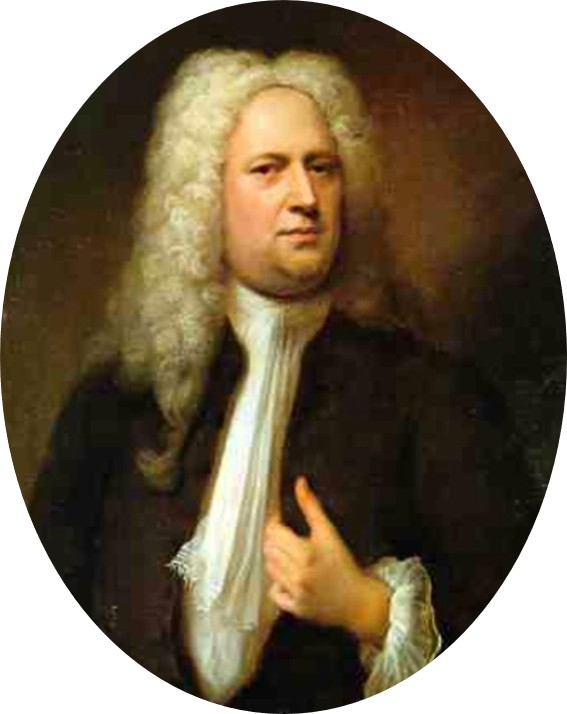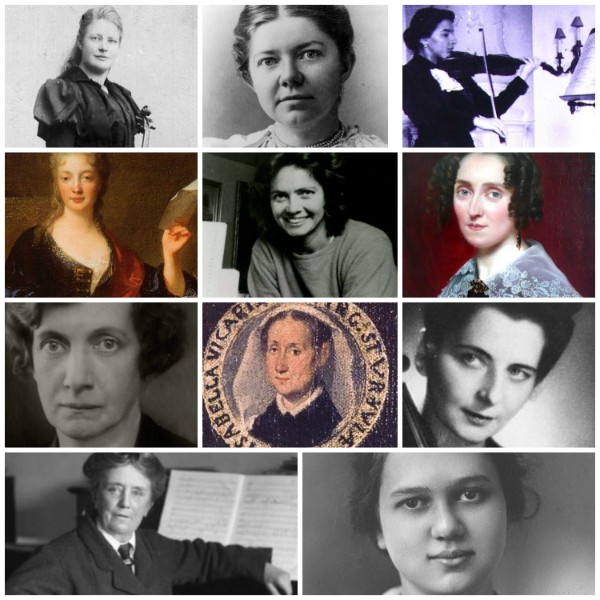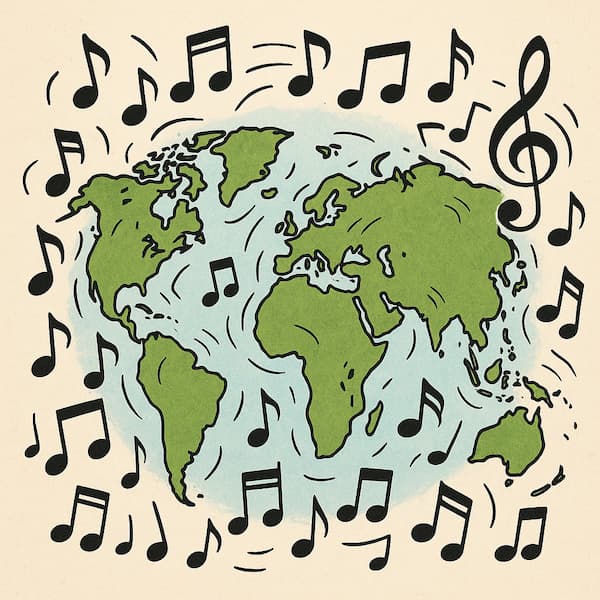In the 19th century, the horn took itself off the battlefield and became part of the orchestra. As a natural horn with no valves, the tuning on a horn had to be controlled by adding extra length to the horn.

Natural Horn and extra modern crooks, ca. 1820 (Courtois horn)
(Photo by Hampson Horns)
In this horn, originally by Courtois Neveu around 1820, the full complement of crooks change the pitch of the horn to high C, high Bb, A, G, F, E, Eb, D, and low C with a coupler for low Bb. The new crooks were made by Richard Seraphinoff. A horn like this would have been used for the music of Mozart, Haydn, and Beethoven.
The crooked natural horn had its limits. Rapid key changes, with rapid crook changes, were nearly impossible. In fact, it was Giacomo Meyerbeer’s horn parts for his 1836 opera Les Huguenots that led to the development of valves for the horn.
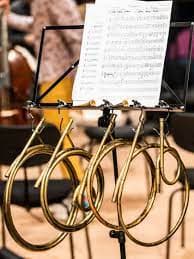
Crooks on a stand for a performance (photo by Nicolas Roudier)
The modern French horn fills in the inner circle of the curled horn with extra tubing that is called into play by the use of valves – in this case, 3 piston valves.
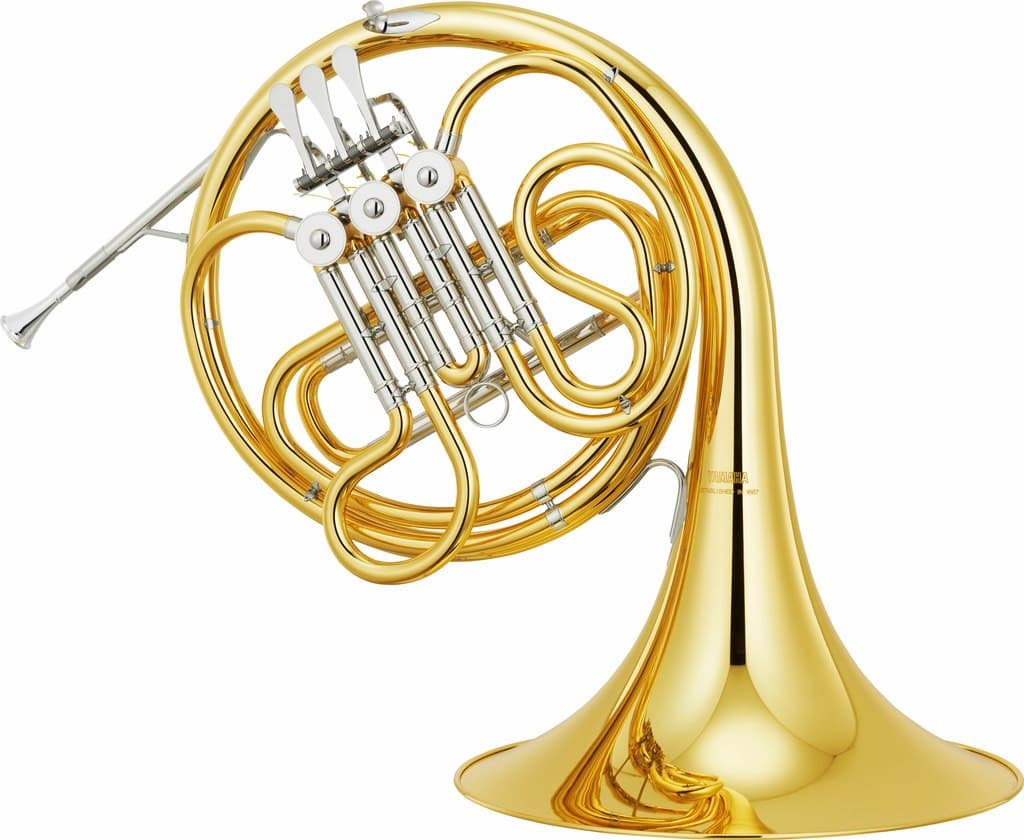
Single horn in F (Yamaha)
A modern double horn, here combining an F and a Bb instrument, is even more complex.

Single horn in F and B Flat (Yamaha)
The horn as an inside instrument gave a rich tone to the middle of the brass section – it would be used to evoke ideas of heroism, magic, and other ideas in keeping with the Romantic spirit of the day.
Let’s start with an overabundance of horns in Schumann’s Concertstück in F Major, Op. 86. Written in 1849 as a concerto, the solo part is actually four solo parts, all taken by horns. It opens with a magnificent horn fanfare and then leads to a broad melody that is the core of the first movement.
Robert Schumann: Concertstück in F Major, Op. 86 – I. Lebhaft (Bremen Deutsche Kammerphilharmonie; Paavo Järvi, cond.)
Schumann’s work was one of the first to take real advantage of the valve horn – in fact, this work was considered unplayable for many years because of its virtuosic requirements.
Another work for horn quartet was Haydn’s Symphony No. 31, given the nickname of Horn Signal. Esterhazy, in 1765, had the virtuoso horn quartet of Carl Franz, Thaddäus Steinmüller, Johann May, and Franz Stamitz, and Haydn was quick to take advantage of their part in his orchestra.
Franz Joseph Haydn: Symphony No. 31 in D Major, Hob.I:31, “Hornsignal” – I. Allegro (American Horn Quartet; Sinfonia Varsovia; Dariusz Wiśniewski, cond.)
To keep in the Vienna area for other horn works, we can look at Mozart and Beethoven. Mozart wrote his horn concertos for his friend, the Salzburg horn player Ignaz Leutgeb, who not only played in the Salzburg orchestra but also appeared in Paris as a horn soloist playing his own concertos. Leutgeb invented the technique of hand-stopping a natural horn, where he could change pitch by inserting his right hand deeper into the bell of the instrument. Mozart was known for playing treks on Leutgeb, most notably in an unfinished Rondo where the orchestra marked Allegro and the horn part is marked Adagio and the margins of the manuscript are filled with abusive comments by Mozart about Leutgeb.
Mozart’s serious writing for Leutgeb was lovely and took advantage of the capabilities of both the player and the instrument.
Wolfgang Amadeus Mozart: Horn Concerto No. 2 in E-Flat Major, K. 417 – III. Rondo (Johannes Hinterholzer, horn; Salzburg Mozarteum Orchestra; Ivor Bolton, cond.)
The Horn Quintet, K. 407, was also written for Leutgeb. Altogether, Mozart composed four concertos and this quintet for him. What’s of interest is that Mozart didn’t accompany the horn with the regular string quartet but substituted a second viola for the second violin that would have normally been used.
Wolfgang Amadeus Mozart: Horn Quintet in E-Flat Major, K. 407 – I. Allegro (Willard Zirk, horn; Arianna String Quartet)
Leopold Mozart also wrote for horn and orchestra, such as in his Hunt Symphony. The full title in English is interesting: The Hunting Symphony / 4 violins / 4 horns in D / 2 horns in G / 2 violas / 1 shotgun / and / bass. Because he’s using natural horns, he has them pitched a fourth apart. He also makes the note that the G horns have a specific role: they should be ‘blown very roughly’ and ‘as forte as absolutely possible. An ox horn can also be used. In that case, many dogs should also be there to bark, and the others should join in with a ‘ho, ho!’ or similar exclamation, but only for six measures’. The work was written around the time of Wolfgang’s birth in 1756.
Wolfgang Amadeus Mozart: Sinfonia da caccia, “Jagd Symphonie” – I. Allegro (German Hornsound; Bamberg Symphony Orchestra; Michael Sanderling, cond.)
Beethoven composed his Horn Sonata, Op. 16, for the hornist Giovanni Punto (1746–1803), and he performed the work together with Punto on 18 April 1800, having created the first sonata for the horn. The horn used here was known as the cor basso, a low horn. The high horn was known as the cor alto and if you look at the list of horn crooks at the beginning of this article, you’ll see crooks for high and low horn listed. The high and low horn used two different mouthpieces – ‘one with a relatively small inner diameter of the rim for the high horn player and one with a relatively large inner diameter of the rim for the low horn player, which produced quite distinct timbres’.
Ludwig van Beethoven: Horn Sonata in F Major, Op. 17 – I. Allegro moderato (Teunis van der Zwart, horn; Alexander Melnikov, piano)
Georg Philip Telemann’s Overture in F major, written while he was in Hamburg, was given its premiere in 1725 to celebrate a visit by the Duke of Brunswick-Lüneburg to Hamburg. Known as the Alster Echo, the Overture may have been performed outside on an island in Alster Lake. One movement that imitated the outdoor setting was the seventh movement, Die Konzertierenden Frosche und Krahen ((The Concert of the Frogs and Crows), which pits the four horns against the woodwinds.
Georg Philipp Telemann: Overture in F Major, “Alster Echo”, TWV 55:F11 – VII. Die Konzertierenden Frosche und Krahen (American Horn Quartet; Sinfonia Varsovia; Dariusz Wiśniewski, cond.)
If we move into the later 19th century, we can hear different ways that the horn was used. In Tchaikovsky’s The Nutcracker Suite, the horn has a prominent part in The Waltz of the Flowers.
Pyotr Ilyich Tchaikovsky: The Nutcracker Suite, Op. 71a – III. Waltz of the Flowers (Cologne New Philharmonic Orchestra; Volker Hartung, cond.)
For a very different sound, we can look at Bizet’s L’Arlésienne Suite No. 1, where in the fourth movement, the horns are not the velvety tones we’re used to but are more pointed and metallic.
Georges Bizet: L’Arlésienne Suite No. 1 – IV. Carillon (Cincinnati Symphony Orchestra; Jesús López-Cobos, cond.)
In Wagner, of course, Siegfried’s horn has a particularly important place. Announcing Siegfried’s arrival in Fafner’s forest, his horn call causes Fafner to emerge from his cave and challenge the hero.
Richard Wagner: Siegfried – Act II Scene 2: Siegfrieds Hornruf (Siegfried’s Horncall) – Haha! Da hätte mein Lied (Simon O’Neill, Siegfried; Falk Struckmann, Fafner; Hong Kong Philharmonic Orchestra; Jaap van Zweden, cond.)
The horn as a hunting horn (Leopold Mozart), as a symphonic voice (Tchaikovsky), as a velvety soloist (W.A. Mozart), and as a magical horn (Wagner) all capture our imagination. Keep an eye on the horn section – when a composer wants the horn line to stand out, he can call for ‘bells up’ – which can mean either raiding the bell of the horn off the lap and holding it at shoulder height or having the entire horn section do this standing, such as at the end of Mahler’s Symphony No. 1.
For more of the best in classical music, sign up for our E-Newsletter
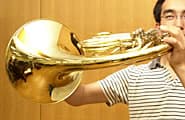
Bells Up (Yamaha)

